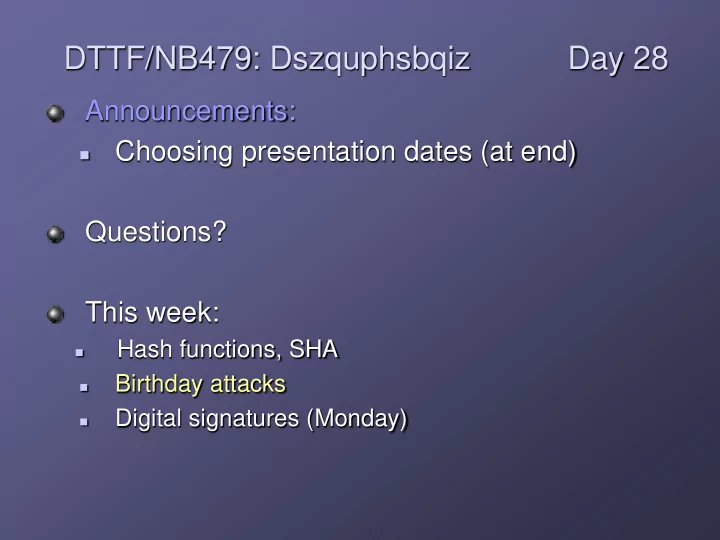

DTTF/NB479: Dszquphsbqiz Day 28 Announcements: Choosing presentation dates (at end) Questions? This week: Hash functions, SHA Birthday attacks Digital signatures (Monday)
1-2 Birthday paradox What’s the chances that two people in our class have the same birthday? Exact solution: use fractions Approximate solution: − 2 r − e 2 N 1 Where r = 26 people, and N = 365 choices
3 The birthday paradox doesn’t mean that there’s a high probability that someone else has my birthday What’s the chance that one of the other students has your birthday? Note: the chance of someone matching me is low, but there are lots of ways to get pairs of matches in general.
4 Likewise, the birthday paradox doesn’t mean that finding a collision with a known digest is easy What’s the chance that one of the other students has your birthday? Key : the chance of someone matching me is low, but there are lots of ways to get pairs of matches in general. Strongly collision-free: Can’t find any pair m 1 ≠ m 2 such that h(m 1 )=h(m 2 ) easily (Sometimes we can settle for weakly collision-free: given m, can’t find m’ ≠ m with h(m) = h(m’).
5 We can calculate how many messages we need to hash to have a good chance of finding a collision How many people are needed to get the probability of having 2 with the same birthday to be above 50%? Derive for general N (not just days in a year)
6 Birthday attacks on SHA-1? How many digests are possible when h is an n-bit hash? This is N. The birthday paradox says I can choose r = sqrt(n) messages and there’s a good possibility that 2 will match. For a 60-bit hash, r = ??? For a 160-bit hash, r = ???
Multicollisions are harder to find, but not as hard as expected. What if instead of finding a just pair of collisions, we need to find 8 collisions?
7 Multicollisions Recall: given r people and N (say, 365) birthdays. r ≈ 1 / 2 If , then there’s a good chance that 2 N people will have the same birthday Generalization: given r people and N birthdays. If ( − k 1 ) ≈ r N k for some k , then there’s a good chance that k people will have the same birthday. So for 160-bit hashes, how many messages do we need to generate to get an 8-collision? That’s lots more than 2 80 ! However, there’s a big underlying assumption: the hash function is random! Is SHA-1 random? (answer on next slide)
No (It’s iterative…)
8 Recall this picture m 1 ’ m 3 ’ m L m 3 m 2 ’ m 2 m 1 h’ h’ h’ h’ =h(m) X L X 3 X 2 X 0 X 1 Consider the following attack: 1. Birthday attack the first block: x1 = h’(x0, m1) 1. Need to generate 2 n/2 messages 2. Result: found (m1, m1’) such that x1 = h’(x0, m1) = h’(x0, m1’) 2. Repeat for x2 and x3, finding pairs (m2, m2’) based on x1 and (m3, m3’) based on x2. 1. Need to generate total of 3 * 2 n/2 messages 2. Result: found 8 combinations (m1, m1’) x (m2, m2’) x (m3, m3’) with same x3. 3. 3 x 2 80 is lots smaller than 2 140 .
The Future of SHA-1?
The best attack so far… On 17 August 2005, an improvement on the SHA-1 attack was announced on behalf of Xiaoyun Wang, Andrew Yao and Frances Yao at the CRYPTO 2005 rump session, lowering the complexity required for finding a collision in SHA-1 to 2 63 .
SHA-3 is not yet standardized 2007: SHA-3 competition announced 2009: 51 submissions cut down to 5 2011: 5 finalists under evaluation Michael Pridal-LoPiccolo (’11) studied Keccak for senior thesis 2013: Keccak chosen! Latest on SHA-3: http://www.nist.gov/itl/csd/sha-100212.cfm
9-12 For your pleasure… What’s the chance that 2 people in a family of 4 have a birthday in the same month ? How big does our class need to be to have: a 99% chance that 2 have the same birthday? a 100% probability (guaranteed) that 2 have the same birthday? Trivia : If a professor posts grades for his class by using the last 4 digits of each student’s SSN, what’s the probability that at least 2 students have same last 4 digits? …for a class at UIUC? (200 students) …for a class at Rose? (30 students)
Recommend
More recommend